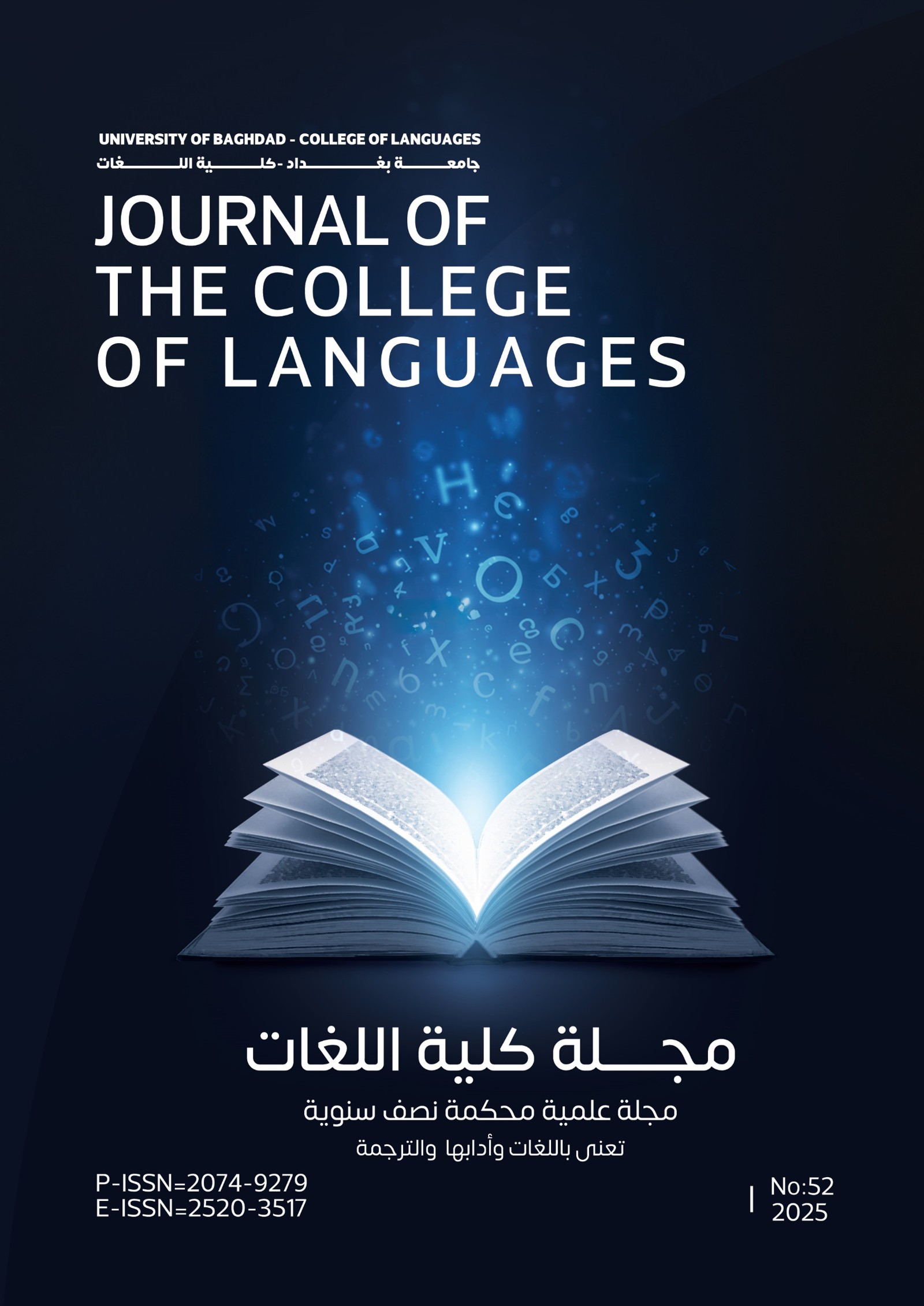Translating Emotions in Dracula's Horror Fiction into Arabic: A Cognitive Appraisal
DOI:
https://doi.org/10.36586/jcl.2.2023.0.47.0001Keywords:
cognition, emotions, effects, translationAbstract
This paper aims to add to the growing body of cognitive translation studies that deal with the translation of emotions and the factors of evaluating the translation process-oriented. Cognitive appraisal is one of the tokens that includes three paradigms of assessing the performance of translation, it can be addressed from the perspective of emotions, intuitions, and individual styles of the SL and the method of transfer into TL. The study hypothesized that translators create a similar emotional charge due to their mental capability to build the same emotional effect in the TL audience. The study also proposed that the applicability of cognitive appraisal is a valuable method of evaluating the translation process, as pertinent to TPR. The study involved two translations for (15) texts including horror situations, and applied three paradigms of cognitive appraisal as a model of analysis, according to the congruence - emotional effects, regulation of emotional - effects, and inference - of emotional effects, to achieve the objective of the research. The study concluded that translators of horror fiction created a sort of emotional effect in TL, but they may vary in the type of strategy adopted to transfer SL into TL.
References
Anastasova, M. (2019). The Suspense of Horror and the Horror of Suspense. Cambridge Scholars Publishing.
Baker, M. (1995). Corpora in translation studies: An overview and some suggestions for future research. Target, 7 (2), 223–245.
Baker, M. (1996). Corpus-based Translation Studies: The challenges that lie ahead. In H. Somers (ed.), Terminology, LSP and Translation: Studies in Language Engineering in honor of Juan C. Sager (P.p. 175–186). Amsterdam: John Benjamins.
Brosch, T., Gilles P., and David S. (2010). The Perception and Categorization of Emotional Stimuli: A Review. In Jan De Houwer and Dirk Hermans (eds.). Cognition and Emotion (P.p. 66–99). Hove and New York: Psychology Press.
Collins, M. (2004). Interactional Expertise as Third Kind of Knowledge. Phenomenology and the Cognitive Sciences, 3: 125–143.
Davou, B. (2007). Interaction of Emotion and Cognition in the Processing of Textual Material. Meta: Translator’s Journal 52 (1): 37–47.
Ellsworth, P., & Scherer, K. R. (2003). Appraisal Processes in Emotion. In R. J. Davidson, K. R. Scherer, & H. Goldsmith Hill (eds.). Handbook of Effective Sciences (P.p. 572–595). Oxford: Oxford University Press.
Fraser, J. (1996). The Translator Investigated: Learning from Translation Process Analysis. The Translator 2 (1): 65–7
Fridja, H., and Scherer, R. (2009). Affect. In D. Sander, & K. R. Scherer (eds.). The Oxford Companion to Emotion and the Affective Sciences (P.p. 10-23). Oxford: Oxford University Press
Fridja, N. & Scherer, K. (2009). Affect. In D. Sander, & K. R. Scherer (eds.). The Oxford Companion to Emotion and the Affective Sciences (P.p.10-26). Oxford: Oxford University Press
Gross, J. (2008). Emotion and Emotion Regulation: Personality Processes and Individual Differences. In Handbook of Personality, in Oliver P. John, Richard W. Robins, and Lawrence A. Pervin (eds.), (P.p. 701–724). New York: The Guildord Press
Hansen, G. (2005). Experience and Emotion in Empirical Translation Research with Think-Aloud and Retrospection. Meta: Translators’ Journal, 50 (2): 511–521.
Hönig, H. (1997). Translating: The constructive Way. Ilha Do Desterro, 33, 11–23.
Hubscher-Davidson, S. (2014). Emotional Intelligence and Translation Studies: A new bridge. META Translators’ Journal. 58 (2), 324–346.
Hubscher-Davidson, S. (2016). Trait Emotional Intelligence and Translation: A Study of Professional Translators. Target 28 (1): 132–157.
Ibrahim, R. and Saman, F. (2016). The Characteristics of Advertising in Blurbs of Arabic and English novels. Journal of the College of Languages. 33: 53-72.
Jääskeläinen, R. (2012). Translation Psychology. In: Yves Gambier and Luc van Doorslaer (eds.). Handbook of Translation Studies, 3: 191–198. Amsterdam and Philadelphia: John Benjamins.
LeDoux, J. (1995). Emotion: Clues from the Brain. Annual Review of Psychology, 46: 209–235.
Lee-Jahnke, H. (2011). Trendsetters and milestones in interdisciplinary process-oriented translation: Cognition, emotion, motivation. In M. Forstner, & H. Lee-Jahnke (eds.). Translation and Interpreting in a New Geopolitical Setting - CIUTI Forum 2010 (P.p.109–151). Bern: Peter Lang.
Lehr, C. (2021). Translation, Cognition and Emotion. In Fabio Alves and Arnt Lykke Jakobsen (eds.). (P.p. 294 - 309). The Routledge Handbook of Translation and Cognition. Routledge
McRae, K., Megan S., Oliver P., and James J. (2011). Context Dependent Emotion Regulation: Suppression and Reappraisal at the Burning Man Festival. Basic and Applied Social Psychology, 33: 346–350.
Mohammed, M. and Kadum, S. (2016). A Discoursal Analysis of Gender Differences in Selected English TV Interviews. Journal of the College of Languages, 34 (1-14)
Muñoz, E., Calvo, N. & García, A. (2018). Grounding Translation and Interpreting in the Brain: What has been, can be, and must be done. Perspectives, 27 (4) 483–509.
Pavlenko, A. (2008). Emotion and Emotion-Laden Words in the Bilingual Lexicon. Bilingualism Language and Cognition, 11, 2: 147–16
Pavlenko, A. (2013). The Encyclopedia of Applied Linguistics. Oxford: Wiley-Blackwell
Phelps, E. (2006). Emotion and Cognition: Insights from Studies of the Human Amygdala. Annual Review of Psychology, 57: 27–53.
Shreve, G., & Koby, S. (1997). What’s in the “black box”? Cognitive Science and Translation Studies. Thousand Oaks: Sage.
Simic, A. (2000). Translation of Horror. Meta, 45(1), 155–157
Stoker, Bram. (1992). Dracula. NewYork Publish
Suri, G., Gal Sh., and James G. (2013). Emotion Regulation and Cognition. In Handbook of Cognition and Emotion. In Michael D. Robinson, Edward R. Watkins, and Eddie Harmon-Jones (eds.), (195–209). New York and London: The Guilford Press.
Suri, G., Gal Sh., and James J. (2013). Emotion Regulation and Cognition. In Michael D. Robinson, Edward R. Watkins, and Eddie Harmon-Jones (eds.) Handbook of Cognition and Emotion. (195–209). New York: The Guilford Press.
Tobias, B., Pourtois, G. and Sander, D. (2010). “The Perception and Categorization of Emotional Stimuli: A Review”. In Jan De Houwer and Dirk Hermans (eds.). Cognition and Emotion (P.p.66–99). Hove and New York: Psychology Press.
Tracy, J., and Richard W. (2008). The Automaticity of Emotion Recognition. Emotion 8 (1): 81–95.
Downloads
Published
Issue
Section
License
Copyright (c) 2022 Journal of the College of Languages (JCL)

This work is licensed under a Creative Commons Attribution 4.0 International License.








